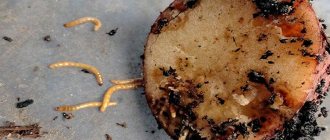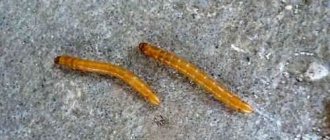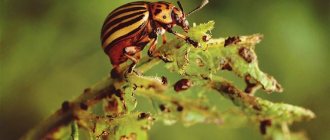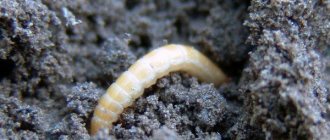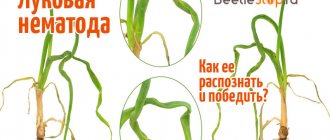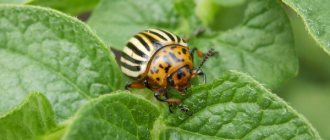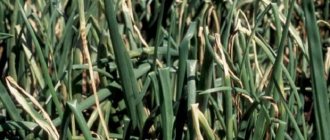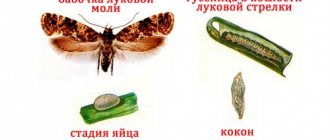Greetings. When caring for vegetables planted in the garden, pay attention to the prevention and control of pests - in particular, wireworms. After all, this parasite is difficult to remove. Therefore, I will share how to get rid of wireworms in the garden forever.
I’ll tell you about methods of getting rid of the pest forever: using specialized means and using traditional methods. We will also consider which preventive methods are effective and help me. And having gotten rid of the uninvited guest, the productivity will increase, and you and I will be glad and happy. Begin…
Wireworm in potatoes: determining the level of acidity and alkalinity of the soil
Wireworm in potatoes: photo
In order to understand what kind of soil is on your site, you need to take a closer look at what plants grow on it. If plantain, sorrel or horsetail grows abundantly in your area, this means that the soil in your area is acidic. You can also determine what kind of soil is on your site experimentally. A handful of soil should be watered with vinegar; if the soil is alkaline, a reaction will immediately follow and the soil will become covered with bubbles. If no reaction occurs, the soil is acidic. Every gardener should remember that the click beetle larva is very afraid of mustard, phytoncides and legumes. Gardeners mainly use mustard to exterminate this pest. As you know, mustard has a very pungent taste, which the wireworm absolutely does not like.
general information
The main targets of wireworm attacks in gardens are potatoes, radishes, turnips, carrots, turnips, and the larvae do not disdain onions.
To effectively fight wireworms, you need to know what it loves and what it hates.
So, the wireworm likes :
- wet places
- acidic soils
- dense plantings and deposits of organic residues
Wireworm loves organic debris
Mustard as a remedy for wireworms in potatoes
Wireworm in potatoes: photo
Typically, mustard is used in powder or used as green manure. When planting plants, mustard powder must be added to the soil. If there is a huge amount of wireworm in your area, then mustard should be mixed with red hot pepper in a ratio of five to it. Mustard can be sown in autumn or early spring as green manure. It is best to sow it throughout the garden plot. Mustard is very unpretentious and can withstand moderate frosts. As soon as the mustard blooms, it must be mowed and the soil must be dug well. You can also fight wireworms by following simple rules of agricultural technology: - do not plant too densely; - reduce the acidity of the soil, for this you can use lime, eggshells; - regular weeding. It is best to reduce soil acidity with the onset of spring. We apply fertilizers and dig the soil deeply. It is best to add lime to the soil no more than once every three years.
How to avoid losing crops due to click beetles
So much has been said about Colorado potato beetles! But they are not the most harmful creatures in the garden. They don’t hide from anyone, sit on damaged leaves, and attract summer residents with their bright colors. But going to war with a wireworm is much more difficult. It cannot be poisoned with chemicals or collected from leaves. And it is quite difficult to survive the yellow worm from the site. But it is possible.
Attention! The click beetle itself looks similar to a ground beetle, but the two can be differentiated. To do this, you need to catch the beetle, turn it over on its back and touch its abdomen. The beetle will jump, making the characteristic clicking sound that gives it its name.
On the left is a wire beetle and its larva, on the right is a false wire beetle.
The wireworm is the larva of a fairly harmless click beetle. These insects wake up at the end of April and begin to lay eggs in the ground to a depth of 2-3 cm. Females of various types of beetles lay up to 200 eggs! After about 2-3 weeks, offspring emerge from the eggs. The larvae live on the site for 3-4 years, then pupate and become beetles.
The wireworm is afraid of green manure
Wireworm in potatoes: photo
Green manure is used not only to control pests and fungi, but also to fertilize the soil. They are grown in plots as organic fertilizers to nourish the soil. Green manure should be sown in the fall, before the onset of frost they have time to bloom, then they are carefully mowed, and the soil on the site is dug up. The click beetle larva is very tenacious. The life cycle of this pest is approximately 5 years. So you can’t get by with just one treatment; you need to prevent the appearance of wireworms from year to year and then this pest will not appear on your site.
Rating of the most effective drugs
If there are a lot of wireworms and you need to eliminate them quickly, the easiest way is to use agrochemicals. Various anti-wireworm preparations for potatoes are popular among gardeners; they have different compositions and principles of action, but many of them are equally effective.
Despite the fact that the means used may be different, the processing process looks approximately the same: put a film on the floor or a flat surface, and lay the tubers on it in one layer. Prepare a pickling solution, pour it into a spray bottle, spray the tubers so that the liquid wets their entire surface. When they are dry, turn them over to the other side. Repeat processing.
The second option: make a solution, pour it into a large container, place the tubers in a mesh and lower it into the liquid. Leave for the time indicated in the instructions. Then dry it by spreading it in one layer in a dry room. Treatment with products should be carried out on the day of planting.
Taboo
Systemic insecticide-protectant for tubers and plant seeds. Protects crops during the period when they are most vulnerable - in the seedling stage. It has a long validity period – up to 1.5 months. The drug is available in the form of a water-suspension concentrate; according to the manufacturer, it is effective regardless of environmental conditions, that is, in any weather. How to use: spray the tubers ready for planting or, alternatively, the soil in the furrows when planting. One treatment is enough, but it should be carried out no later than 3 months before digging up the tubers - that is how long the waiting period for the drug lasts.
Prestigator
This is a suspension concentrate intended for treating tubers before planting. It can be combined with antifungal agents and growth stimulants. When planting the treated tubers, you can fertilize them with fertilizers; the drug does not compete with them.
Prestigitator protects potatoes throughout the growing season; the time for complete decomposition of the active ingredients is 2 months. In this regard, it cannot be used on early varieties.
Zemlin
The drug fights not only wireworms, but also mole crickets. Time of use – dressing of planting tubers in spring and autumn preventive tillage. The insecticide is mixed with sand and this anti-wireworm agent is applied when planting in holes or granules are scattered over the area. The validity period of Zemlin against wireworm is 2 months, so for most varieties one treatment is usually sufficient.
Prestige
One of the most famous insecticides. They are used to treat the tubers before planting. It protects not only from wireworms, but also from another dangerous enemy of nightshades - the Colorado potato beetle. It has a fungicidal effect and protects against fungal infections. It increases germination, strengthens the immune system, and plants treated with it can more easily withstand changing weather conditions. Combines with growth stimulants and complex fertilizers. Protects potato bushes from wireworms throughout the entire period of their growth. Restriction on the use of Prestige: not suitable for early varieties.
Zarit
In addition to wireworms, it destroys mole crickets. The granules are laid out on the site or buried in the ground to a depth of 5-10 cm.
Initiative
Microgranules of poison are embedded in the soil, evenly distributing them in it, which ensures the necessary contact with pests. Destroys them within 24 hours, valid for 1.5 months. Pochin is not phytotoxic; it cannot be mixed with other agrochemicals.
Chops
The drug is a ready-made bait for poisoning pests. These are granules that are evenly embedded in a layer of earth at a depth of 5-10 cm. Rubit should not be mixed with fertilizers or any medications. The insecticide is non-toxic for plants.
Barguzin
Barguzin is available in the form of emulsion concentrate and granules. According to the instructions for use, its effect is noticeable within 3-4 days after treatment - application to the soil when planting or detecting wireworms. Protects plants for more than 3 weeks, which is quite enough at the initial stages of their growth. It is non-toxic for all types of plants and is compatible with many agrochemicals of different classes.
Provotox
To kill the pests, a single application of Provotox against wireworms in the holes during planting is sufficient. You can distribute it over the entire area of the beds, embedding the granules to a shallow depth. It is not recommended to use the insecticide on early varieties of potatoes and mix it with other agricultural products.
How to calm the husk?
Having been reading my favorite magazine for several years now, as usual, from cover to cover, I have accumulated so many questions, wishes, and thoughts that it’s time to cast aside my shyness and finally pick up a pen. But there is so much that I don’t know where to start! Well, I’ll probably start with potatoes - this is, after all, our second bread.
We bought a long-abandoned plot on the river bank, plowed it up and in the first year planted three buckets of potatoes, a bed of onions, 10 tomato roots and three cucumber roots. We didn't have time to do anything else. The plants grew so frail that all desire to garden immediately disappeared.
Autumn has come, they started digging potatoes, and there was no harvest, but only tears: all the tubers were eaten away by wireworms. And besides, they grew up small. Apparently, this wireworm itself became hungry on such “pea” potatoes and spread to other plantings, because it heartily ate not only cucumbers and tomatoes, but even onions. The husband jokingly said: “And how did the wireworm’s eyes not fall out when he was eating the onion?”
In general, our first gardening season ended in complete embarrassment. Some of our neighbors grinned at our “successes,” others pretended that nothing special had happened, but there were also kind people who advised us to cover the entire area with onion peels. Well, why not try it? But where can you get so much of this goodness? We decided to go to a vegetable warehouse in the city. At that time it was strict there: even rot had to go through the weighing room first, and then only go to the dump.
Well, we agreed there, and two cars with onion peels (when they scattered them, there were rotten onions and substandard garlic) headed straight to our dacha - just enough to cover the entire garden in an even layer.
We had just finished working when suddenly a strong wind blew - the husks rose and swirled like rose petals in some Indian film - and at any moment they would fly away to the neighbors. We rushed to water it: I with a watering can, my husband with a hose.
They barely calmed down. So then they watered it until it snowed. And in the spring, they brought sand and soil by the dump truck (or maybe peat, I don’t remember), plowed everything with a tractor and then went through it two more times with a cultivator (at that time we were one of the first to have it).
And finally, before planting, I did as my mother advised: along the perimeter of the entire area, using a watering can without a nozzle, I spilled the soil with a thick solution of table salt.
When autumn came, the neighbors no longer grinned, but only asked: “Have you entered into an agreement with the pests?” “Of course,” we answered, “we agreed, but not with the “adversaries,” but with the earth.” Our harvest then was like in a fairy tale. And until now, although many years have passed, we do not suffer from this infection - wireworm, but from time to time, for prevention, we put a whole bag of husks, or even two, into the beds every year, and then embed them in the ground (with watering don't bother anymore).
Description of the potato pest
The size of the wireworm ranges from 1 to 5 cm. As mentioned above, it has a hard body, like wire. Color can vary from yellow to dark brown. It will be difficult to crush him.
Photo of wireworm
The development of the click beetle takes place over 5 years, while it remains in the larval stage for 3 or even 4 years. In the first year of life, the larva is not as dangerous as when it matures. In the 4th year pupation occurs.
Wireworms eat almost everything. They are considered polyphagous.
They consume roots, stems, and shoots. They eat seeds and seedlings. Passages are made in the fruits, and therefore they are poorly stored and become completely unsuitable for food.
Photos of the main stages of development of the click beetle
Nematode Nemabact
This is a biological product based on parasitic nematodes. The manufacturer assures that this bioinsecticide is harmless to humans, animals, and plants. It is a hybrid of a nematode as a natural enemy of the wireworm. The nematode finds a victim and parasitizes it in the ground.
As a result, you can protect yourself from wireworms in this way with a two-year guarantee. Before use, be sure to read the instructions and strictly follow them. There are practically no analogues to the drug; there is “Protection” soil with the addition of nematodes, and a similar one is Antonem-F.
10 things to do at the dacha in April
Herbal infusions
Watering potatoes with herbal infusions will allow small areas to effectively say goodbye to many pests. We alternate watering with different types of infusions.
- Take separately into a bucket of water: nettle (500 g), celandine (100 g), dandelion (200 g). Celandine is infused in hot water for 72 hours, dandelion and nettle for up to 12-16 hours. You can calculate the ratio by brewing the herbs, then pour them into a larger container by adding water. And then water the planted potatoes or holes before planting. 2-3 such waterings will be required per week.
- Using tansy: take a kilogram of the plant per bucket of water. Brew in hot water and leave in a dark place until the foam disappears. Do not use metal utensils. The infusion is used for irrigation in a ratio of 1:20.
- Before planting, you can treat the tubers in an infusion of celandine or wormwood.
